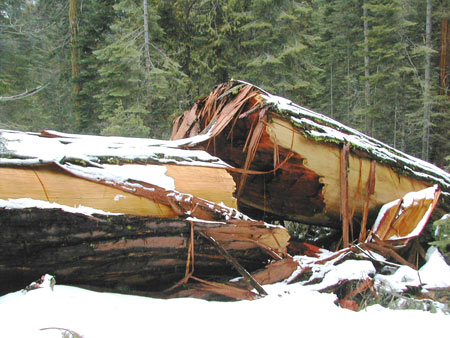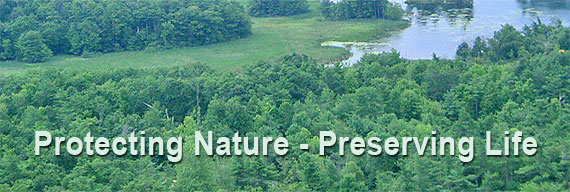Chapter 7
The Big Trees
Between the heavy pine and silver fir zones
towers the Big Tree (Sequoia
gigantea), the king of all the conifers in the world, "the noblest
of
the noble race." The groves nearest Yosemite Valley are about twenty
miles to the westward and southward and are called the Tuolumne, Merced
and Mariposa groves. It extends, a widely interrupted belt, from a very
small grove on the middle fork of the American River to the head of
Deer
Creek, a distance of about 260 miles, its northern limit being near the
thirty-ninth parallel, the southern a little below the thirty-sixth.
The
elevation of the belt above the sea varies from about 5000 to 8000
feet.
From the American River to Kings River the species occurs only in small
isolated groups so sparsely distributed along the belt that three of
the gaps in it are from forty to sixty miles wide. But from Kings River
south-ward the sequoia is not restricted to mere groves but extends
across the wide rugged basins of the Kaweah and Tule Rivers in noble
forests, a distance of nearly seventy miles, the continuity of this
part
of the belt being broken only by the main cañons. The Fresno,
the
largest of the northern groves, has an area of three or four square
miles, a short distance to the southward of the famous Mariposa grove.
Along the south rim of the cañon of the south fork of Kings
River there
is a majestic sequoia forest about six miles long by two wide. This is
the northernmost group that may fairly be called a forest. Descending
the divide between the Kings and Kaweah Rivers you come to the grand
forests that form the main continuous portion of the belt. Southward
the giants become more and more irrepressibly exuberant, heaving their
massive crowns into the sky from every ridge and slope, waving onward
in
graceful compliance with the complicated topography of the region. The
finest of the Kaweah section of the belt is on the broad ridge between
Marble Creek and the middle fork, and is called the Giant Forest. It
extends from the granite headlands, overlooking the hot San Joaquin
plains, to within a few miles of the cool glacial fountains of the
summit peaks. The extreme upper limit of the belt is reached between
the
middle and south forks of the Kaweah at a height of 8400 feet, but the
finest block of big tree forests in the entire belt is on the north
fork
of Tule River, and is included in the Sequoia National Park.
In the northern groves there are
comparatively few young trees or
saplings. But here for every old storm-beaten giant there are many in
their prime and for each of these a crowd of hopeful young trees and
saplings, growing vigorously on moraines, rocky edges, along water
courses and meadows. But though the area occupied by the big tree
increases so greatly from north to south, here is no marked increase
in the size of the trees. The height of 275 feet or thereabouts and a
diameter of about twenty feet, four feet from the ground is, perhaps,
about the average size of what may be called full-grown trees, where
they are favorably located. The specimens twenty-five feet in diameter
are not very rare and a few are nearly three hundred feet high. In
the Calaveras grove there are four trees over 300 feet in height, the
tallest of which as measured by the Geological Survey is 325 feet. The
very largest that I have yet met in the course of my explorations is
a majestic old fire-scarred monument in the Kings River forest. It is
thirty-five feet and eight inches in diameter inside the bark, four
feet above the ground. It is burned half through, and I spent a day
in clearing away the charred surface with a sharp ax and counting the
annual wood-rings with the aid of a pocket lens. I succeeded in laying
bare a section all the way from the outside to the heart and counted a
little over four thousand rings, showing that this tree was in its
prime
about twenty-seven feet in diameter at the beginning of the Christian
era. No other tree in the world, as far as I know, has looked down on
so
many centuries as the sequoia or opens so many impressive and
suggestive
views into history. Under the most favorable conditions these giants
probably live 5000 years or more though few of even the larger trees
are
half as old. The age of one that was felled in Calaveras grove, for the
sake of having its stump for a dancing-floor, was about 1300 years, and
its diameter measured across the stump twenty-four feet inside the
bark.
Another that was felled in the Kings River forest was about the same
size but nearly a thousand years older (2200 years), though not a very
old-looking tree.
So harmonious and finely balanced are even
the mightiest of these
monarchs in all their proportions that there is never anything
overgrown
or monstrous about them. Seeing them for the first time you are more
impressed with their beauty than their size, their grandeur being in
great part invisible; but sooner or later it becomes manifest to the
loving eye, stealing slowly on the senses like the grandeur of Niagara
or of the Yosemite Domes. When you approach them and walk around them
you begin to wonder at their colossal size and try to measure them.
They
bulge considerably at the base, but not more than is required for
beauty
and safety and the only reason that this bulging seems in some cases
excessive is that only a comparatively small section is seen in near
views. One that I measured in the Kings River forest was twenty-five
feet in diameter at the ground and ten feet in diameter 220 feet above
the ground showing the fineness of the taper of the trunk as a whole.
No
description can give anything like an adequate idea of their singular
majesty, much less of their beauty. Except the sugar pine, most of
their
neighbors with pointed tops seem ever trying to go higher, while the
big
tree, soaring above them all, seems satisfied. Its grand domed head
seems to be poised about as lightly as a cloud, giving no impression
of seeking to rise higher. Only when it is young does it show like
other conifers a heavenward yearning, sharply aspiring with a long
quick-growing top. Indeed, the whole tree for the first century or
two, or until it is a hundred or one hundred and fifty feet high, is
arrowhead in form, and, compared with the solemn rigidity of age, seems
as sensitive to the wind as a squirrel's tail. As it grows older, the
lower branches are gradually dropped and the upper ones thinned out
until comparatively few are left. These, however, are developed to a
great size, divide again and again and terminate in bossy, rounded
masses of leafy branch-lets, while the head becomes dome-shaped, and is
the first to feel the touch of the rosy beams of the morning, the last
to bid the sun good night. Perfect specimens, unhurt by running fires
or
lightning, are singularly regular and symmetrical in general form
though
not in the least conventionalized, for they show extraordinary variety
in the unity and harmony of their general outline. The immensely
strong,
stately shafts are free of limbs for one hundred and fifty feet or so.
The large limbs reach out with equal boldness a every direction,
showing
no weather side, and no other tree has foliage so densely massed, so
finely molded in outline and so perfectly subordinate to an ideal type.
A particularly knotty, angular, ungovernable-looking branch, from five
to seven or eight feet in diameter and perhaps a thousand years old,
may occasionally be seen pushing out from the trunk as if determined to
break across the bounds of the regular curve, but like all the others
it dissolves in bosses of branchlets and sprays as soon as the general
outline is approached. Except in picturesque old age, after being
struck
by lightning or broken by thousands of snow-storms, the regularity of
forms is one of their most distinguishing characteristics. Another is
the simple beauty of the trunk and its great thickness as compared with
its height and the width of the branches, which makes them look more
like finely modeled and sculptured architectural columns than the stems
of trees, while the great limbs look like rafters, supporting the
magnificent dome-head. But though so consummately beautiful, the big
tree always seems unfamiliar, with peculiar physiognomy, awfully solemn
and earnest; yet with all its strangeness it impresses us as being more
at home than any of its neighbors, holding the best right to the ground
as the oldest strongest inhabitant. One soon becomes acquainted with
new
species of pine and fir and spruce as with friendly people, shaking
their outstretched branches like shaking hands and fondling their
little
ones, while the venerable aboriginal sequoia, ancient of other days,
keeps you at a distance, looking as strange in aspect and behavior
among
its neighbor trees as would the mastodon among the homely bears and
deers. Only the Sierra juniper is at all like it, standing rigid and
unconquerable on glacier pavements for thousands of years, grim and
silent, with an air of antiquity about as pronounced as that of the
sequoia.

NEXT...
|













